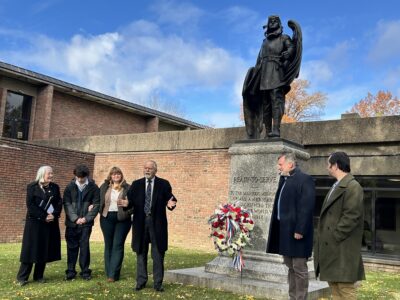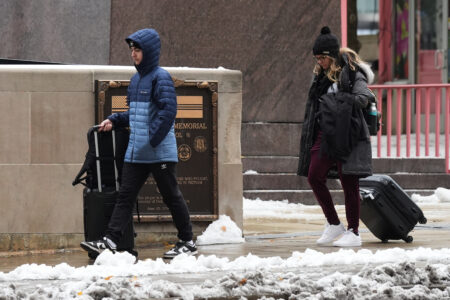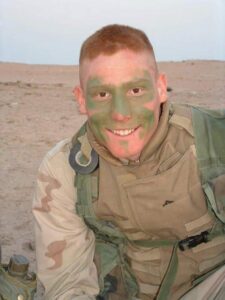Linsly’s ‘Aviator’ Statue Turns 100

photo by: Joselyn King
Members of the McKinley family – descendants of World War I aviator Louis Bennett – gather to place a wreath at the base of “The Aviator” statue during the 100th anniversary of the statue celebrated Tuesday at The Linsly School. Pictured from left are Mary McKinley, Louis McKinley, Katy McKinley, former U.S. Rep. David B. McKinley, R-W.Va., David H. McKinley and Bennett McKinley.
WHEELING — “The Aviator” statue has now been inspiring bravery and moral values at The Linsly School for a century.
On Tuesday, the school held a special rededication for the statue that was first unveiled and gifted to the school 100 years ago on Armistice Day, Nov. 11, 1925. Armistice Day would later come to be called Veterans Day.
The statue honors the memory of a West Virginia-born World War I flying ace, Louis Bennett.
“For a century now, ‘The Aviator’ has stood as a symbol of bravery, vision and service above self,” said Justin Zimmerman, head master at The Linsly School. “These are values that continue to guide and inspire our students and community.”
Among those on hand for the rededication were members of the family of former U.S. Rep. David B. McKinley, R-W.Va. – all descendents of Louis Bennett.
McKinley reminded those in attendance that just 4% of Americans have ever served in the military, and that “these men and women are to be celebrated.”
At the time it was placed on Nov. 11, 1925, “The Aviator” was the first statue in West Virginia to honor a World War I veteran. It was initially placed at what was then The Linsly School at Thedah Place just across Wheeling Creek.
McKinley credits his great-great aunt, Sally Maxwell Bennett, for commissioning the statue of her son and bringing it to Linsly. She was later instrumental in getting aviator Charles Lindbergh – just weeks after his famous flight to Europe – to place a wreath at its base in 1927.
McKinley spoke about Louis Bennett, a native of Weston who was fascinated by mechanical equipment. By the age of 12, he had assembled the first motorized bicycle in West Virginia. A year later, he built an automobile.
He went to graduate from Yale University in 1917, then settled in Wheeling. At age 22, Bennett founded the West Virginia Aircraft Company in Warwood with his brother-in-law, Johnson Camden McKinley – also McKinley’s grandfather. They built aircraft for the British and French war departments. But Bennett’s aviation unit would be rejected for service during World War I.
Disappointed, Bennett would enlist in the British Royal Flying Corps so as to see aviation action during the war.
There were no GPS systems or other technology in planes at that time, and pilots flew on the basis of their instinct, McKinley explained.
“(Bennett) was only 5 foot, 7 inches and weighed 145 pounds, but he feared nothing,” he said.
The life expectancy of fighter pilots was short, and most survived only as long as six to 10 weeks, McKinley continued. Survival rates were even less for those in the skies over France, where Bennett would eventually meet his fate.
Bennett became an “ace” quickly after shooting down 10 enemy aircraft during his first 10 days on the western front, McKinley reported. He would be shot on Aug. 24, 1918 – just 89 days before the end of the war.
McKinley noted the British didn’t award metals posthumously, and the French weren’t inclined to give Bennett any award he had earned for fighting over France. In addition, the Americans didn’t give him any award for service as he was not enlisted with the U.S. military.
Sally Maxwell Bennett, after much effort, was able to retrieve his remains and return them to America. She then commissioned “The Aviator” statue and other memorials for her son.
“Sally Maxwell Bennett took it upon herself to see that her son’s valor and sacrifice would be forever memorialized,” McKinley said. “She not only commissioned this magnificent bronze statue, but she had a large stained glass window dedicated on his behalf and it hangs in the famed Westminster Abbey in London.”
Sally Maxwell Bennett also converted the family home in Weston into the Louis Bennett Jr. Memorial Library.
“Mrs. Bennett was truly a woman on a mission,” McKinley added.
Among those also speaking at Tuesday’s rededication was Charles D. Dusch – a member of the Linsly class of 1977, Air Force combat veteran and acting command historian for the U.S. Air Force Academy.
He pointed out to the high school students present that Louis Bennett was their age when he set out on his young dreams to build planes, be an aviator and fighter pilot.
Dusch also provided some additional historical facts.
“The survivors and the families (of World War I fallen veterans) held this day sacred, and they wanted to dedicate ‘The Aviator’ statue on this day in 1925,” he said.
Also, Sally Maxwell Bennett had not been permitted to travel to France to retrieve her son’s remains by the U.S. government “because she was a woman,” according to Dusch.
He noted the Wheeling Intelligencer provided her with press credentials so she could make the trip.




